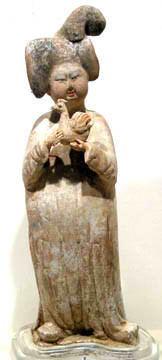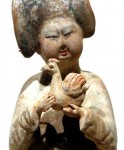
Unknown
Chinese
Lady with Bird, 618-906, Tang dynasty
earthenware with traces of pigment
16 1/2 x 5 1/4 x 5 1/4 in.
SBMA, Museum purchase with funds in memory of Elizabeth Tanner Atkins
2000.20

Lady with Bird
COMMENTS
Women of imposing physical stature (or the so called "fat ladies") represented the ideal of feminine beauty for the Tang dynasty (618-907A.D.) imperial court. Their images were among the best and most expressive of Chinese funerary sculptures, reflecting the prosperity and confidence of the period. Conceived in simple, almost abstract forms, this well-composed court lady gently holds a bird, conveying an air of elegance and monumentality.
Her minimally modeled facial features and small, delicate hands contrast sharply with the bold contours of her body, revealed through the rhythmic folds of her dress. Her hair is dramatically combed out on the right side of her head, and piled high in an elaborate "butterfly" bun on the left—a high-fashion statement during the 8th century.
Full-figured ladies are often identified with Yang Guifei, the favorite concubine of Tang emperor Xuanzong (713-756 A.D.). Known to have been a woman of imposing size, Yang Guifei was often considered the inspiration for the funerary sculptures. However plump ladies of this type have been excavated from early 8th century tombs, suggesting that the form pre-dates this famous courtesan.
Funerary figures were produced in China from around the 4th century B.C., to accompany the deceased to the afterlife, replacing the earlier practice of human and animal sacrifices. The large number of these figures found in Tang tombs attests to the importance of funerary rites and the affluence of Tang society. Though some may have been sculpted individually, most were made in molds with hands and heads modeled separately. Many painted "fat ladies" made from buff or reddish clay have been found in the vicinity of modern-day Xian, in Shaanxi province, the site of the ancient Tang-dynasty capital, Changan.
This beautiful figure was acquired through a generous gift from the Atkins family in loving memory of Elizabeth "Tammy" Atkins who was a longtime friend of the Museum and a great supporter of its Asian art program in particular.
- Susan Tai, Curator of Asian Art
SBMA CURATORIAL LABELS
Women of imposing physical stature represent the ideal of feminine beauty in the Tang court. Figures like this one are among the best and most expressive funerary sculptures of the time, reflecting the prosperity and confidence of the Tang period.
- Asian Art Reopening, 2021
